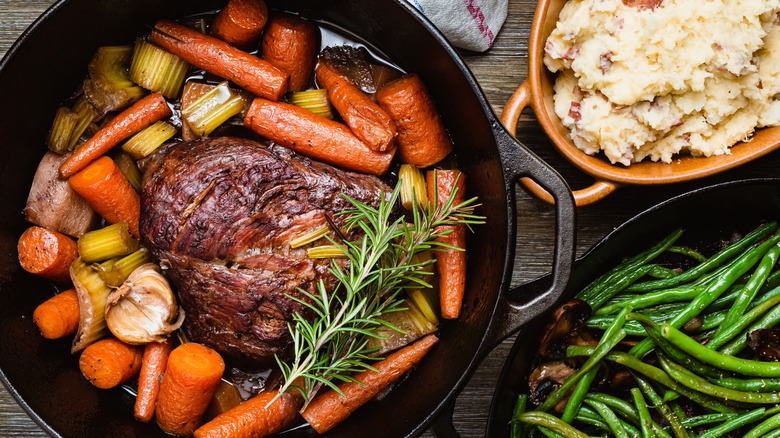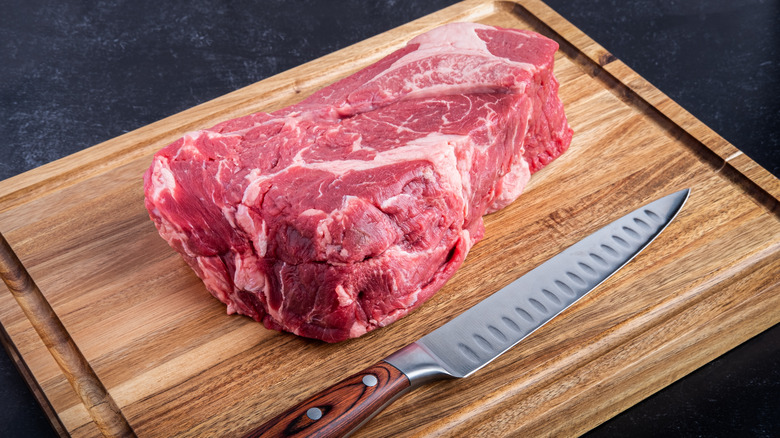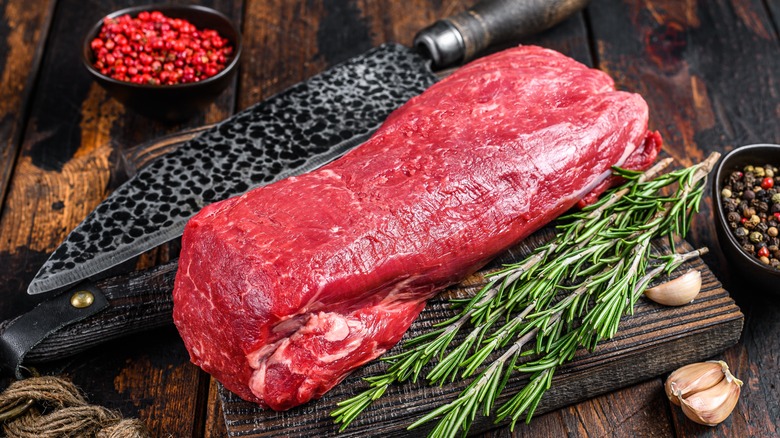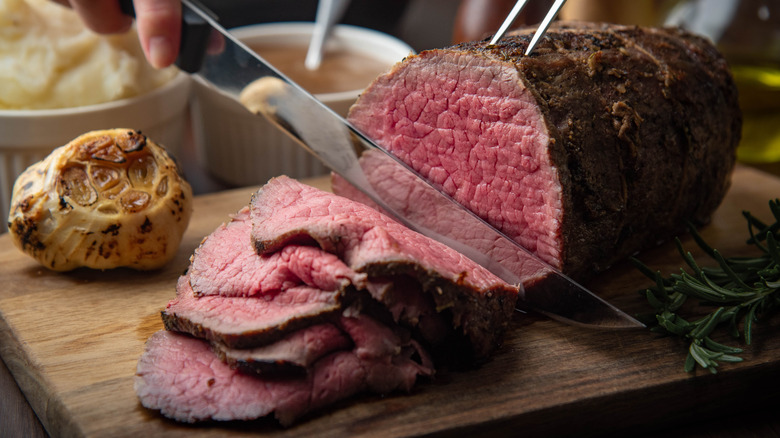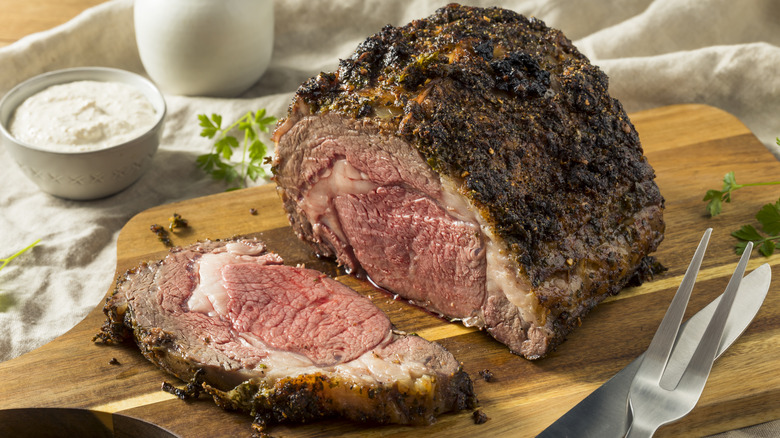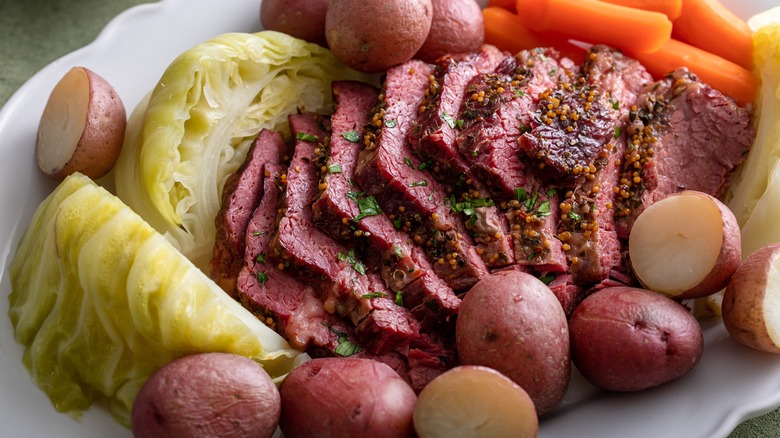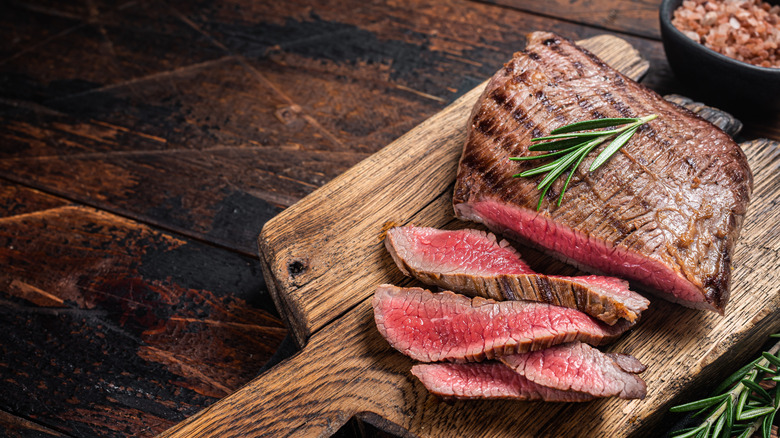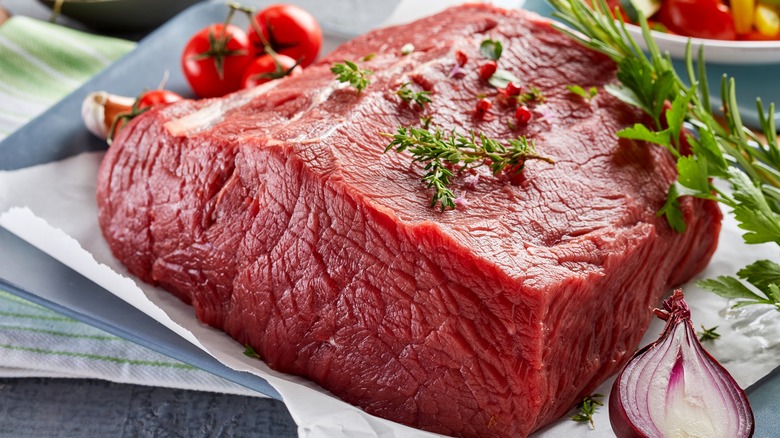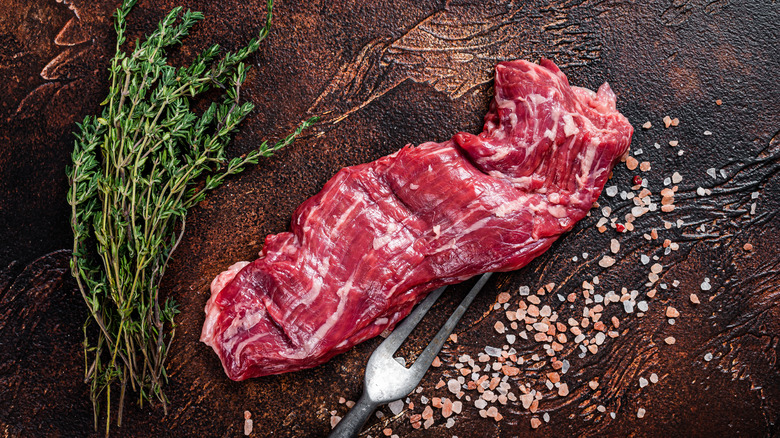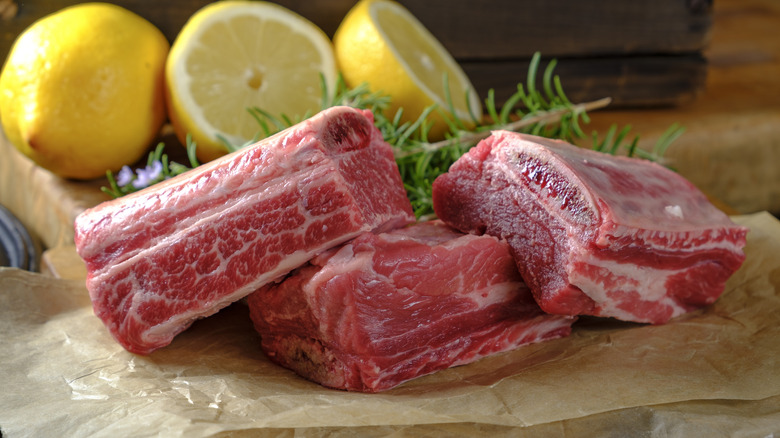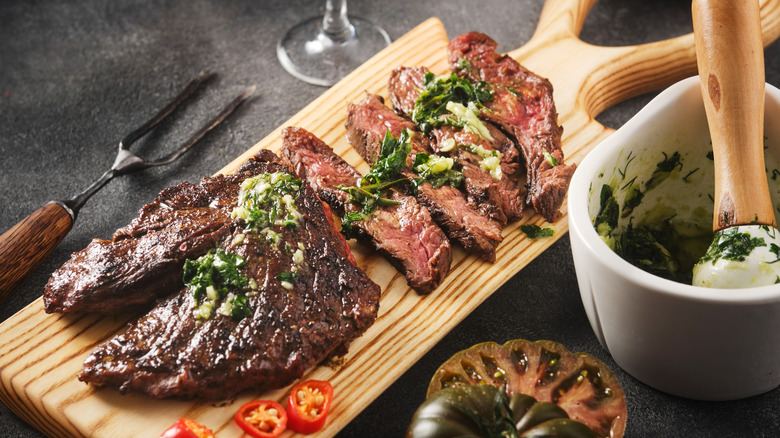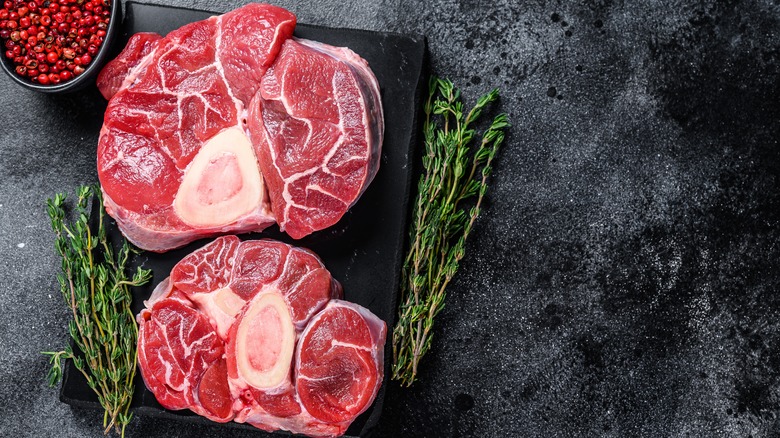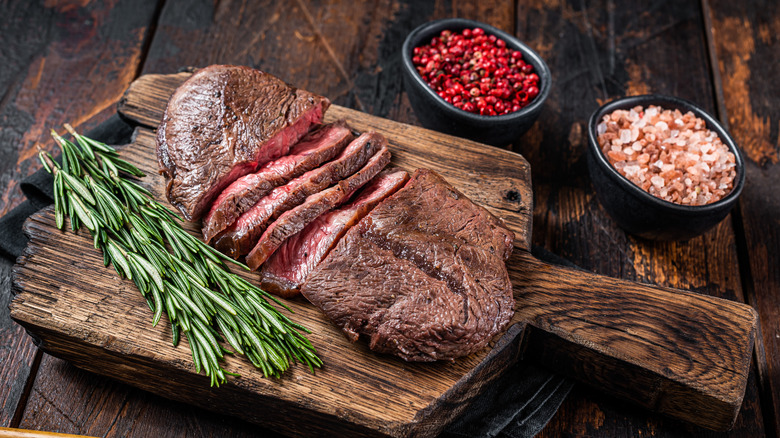6 Cuts Of Meat That Are Perfect For Pot Roast And 6 You Should Avoid
Pot roast is what it sounds like — meat stewed in a pot. Sounds easy enough, but is it? Among the many mistakes people make when cooking pot roast is selecting the right meat to put in said pot. There are several considerations for this beyond affordability and convenience — two of the hallmark features that make pot roast so desirable.
As a chef, I have spent nearly two decades learning how to coax flavor out of tough cuts of meat that can be hard to work with. Identifying which cuts are tough versus tender is relatively simple to do. It is all about location. Cuts derived from parts of the cow that get a lot of exercise throughout the animal's lifespan are always denser than those that do not. Generally speaking, cuts from the shoulders and rear of a cow qualify as tough, while those from the loin are tender.
These tough cuts are rife with connective tissue and lack the intramuscular fat or marbling that translates to juicy meat. Dense, fibrous connective tissues require time and moisture to be slowly coerced into submission. This is what is necessary for a quality pot roast. To help take the guesswork out of selecting the appropriate meat for pot roast, I have compiled a list of cuts to use and those to avoid based on my experience and expertise. I have included why they are or are not ideal for pot roast and some general guidelines for what to look for.
Buy: Chuck roast
The terms chuck roast and pot roast are often interchangeably used, even though they are not identical. Pot roast is the cooking method often employed to cook a chuck roast, and a chuck roast is one of the most commonly used cuts of meat to cook pot roast. The chuck hails from the shoulder region of the cow. It is a muscle that meets the criteria for a good pot roast. It is a highly used muscle that is rife with fat and connective tissue and lacks the marbling of tender cuts.
What makes the chuck so desirable is its distinctive, robust beefy flavor. It is also valued because it is inexpensive, making it easy to feed a large family without breaking the bank. The chuck can be obtained with or without a bone. Boneless will set you back more than bone-in, but both are cost-effective. Boneless chuck has advantages in a pot roast because it eliminates the need to hunt for bones in the stew after it has finished cooking and is easier to slice.
You will find chuck roast labeled under different names when shopping for it. This has to do with how the cut is butchered. Search for blade pot roast, beef chuck eye roast, and a petite tender roast. These are all obtained from the chuck and will work beautifully for your next pot roast.
Avoid: Tenderloin
A cut with the word "loin" in the name, such as the tenderloin, is not well-suited for pot roast. As I have already noted, most of the tender cuts of beef that are abundant in intramuscular fat or marbling are obtained from the muscles contained within the underutilized loin of the cow. The tenderloin is the source of the beloved filet mignon, a steak among the most popular cuts for a dinner party. This muscle is located along the back of the cow toward its rear end. Because of its distinctive tender texture, the tenderloin is a highly prized and expensive cut of beef.
While the tenderloin is remarkably moist and juicy when cooked properly, it lacks the savory, umami-rich beefiness of more dense cuts. It also becomes mushy or disintegrates when subjected to low-and-slow cooking methods, such as a pot roast. This is a cut that's best roasted whole in the oven, or cut into steaks that can be grilled, pan-seared, broiled, or reverse-seared. It is ideally served at a medium-rare temperature where the meat is pink but not bloody.
Buy: Round roast
Another cut that is frequently used for pot roast is the round roast. The round primal is located in the hindquarters of the cow. The rump and back legs are one of the most exercised portions of the cow, meaning the meat obtained from this region is incredibly lean, lacking in intramuscular fat or marbling, and abundant in connective tissue. Cuts obtained from this region do not lend themselves to high-heat cooking methods, like grilling or pan-searing. This can result in chewy, inedible meat. Slow, moist cooking methods, like braising, are ideal to slowly dissolve the collagen within the connective tissues of the meat, yielding a moist result.
The round can be divided into three segments. When shopping for this inexpensive cut of beef, you will want to look for these. The top round hails from the inside of the back leg of the cow. The bottom round is sourced from the exterior of the cow's hind legs. The primary difference between these is size, with the top round being more substantial in girth and weight than the bottom round. The eye of the round is a subsection of the bottom round. This portion is obtained from the center of the round. It is considered the leanest and most dense cut of the round primal, requiring more cooking time and patience to obtain tender results.
Avoid: Rib roast
The rib roast is obtained from the rib primal of the cow. This region is located along the side of the cow behind the chuck or shoulders, and ahead of the coveted loin. The primary responsibility of this part of the cow is supporting the animal's backbone. The expensive prime rib hails from this segment, specifically the section between the sixth and twelfth ribs. The remaining part of the rib roast is generally cut into steaks.
The meat from this area of the cow is known for being incredibly tender, with adequate intramuscular fat and a substantial fat cap that keeps the meat moist as it is roasted, grilled, or smoked. Among the biggest mistakes you can make when cooking a prime rib or rib roast is overcooking it. Doing so can cause meat from this cut to become dry and chewy. For this reason, it is contraindicated for use in pot roast. My preferred method for preparing a prime rib is to liberally season it and pop it in the oven until it is medium-rare, or a meat thermometer registers 130 to 135 degrees Fahrenheit. The juicy slices are perfect for an elegant meal or a special occasion.
Buy: Brisket
When thinking about cuts of meat appropriate for pot roast, one need not think further than corned beef and cabbage. The cut of meat used in corned beef and cabbage (essentially a type of pot roast) is a beef brisket. Each cow has two briskets, which hail from the front portion of the animal, below the chuck, ahead of the plate, and above the shank. In characteristic fashion for cuts that are great in pot roast, this muscle gets a lot of exercise throughout the cow's lifespan, making it dense but flavorful. The cut has abundant connective tissues, collagen, and a distinctive fat cap.
Each brisket is divided into two segments by a layer of fat — the flat (or first cut) and the point (or the second or deckle cut). The former is larger and more uniform in shape and leaner. The latter is smaller, has an irregular shape and thickness, is fattier, and possesses a more notable robust, beefy flavor. Both are suitable for pot roast, though you will often find the brisket sold whole with both pieces intact. Should you purchase a whole brisket for pot roast, you will want to note that the two sections have grains that run in opposite directions. This will be important when carving the meat before you serve your pot roast, as you always want to cut against the grain for the most tender results.
Avoid: Flank steak
The flank steak is a member of the beef family known as the flat cuts. These cuts, sourced from the undergird of the cow, get their moniker from their unique flat, elongated shapes. The flank steak is below the short loin and bottom sirloin primal and behind the plate. It has an elliptical, even shape and tends to be between ¾ of an inch and 1 inch in width. It's a relatively lean cut known for its savory, beefy flavor and sinewy muscle fibers that run along its length, which give it a chewy texture if not carefully sliced against the grain.
Based on these characteristics, one may think this inexpensive cut of beef would be ideal for a pot roast. Unfortunately, the distinct morphology of the flank makes it very challenging to cook. It does not respond well to over or undercooking, making it best suited to cooking methods where you can control doneness carefully, such as grilling, pan-searing, or roasting. This cut should never be cooked beyond medium-rare, between 130 and 135 degrees Fahrenheit. Additionally, it benefits from a long soak in an acidic marinade to season it and help tenderize its muscle fibers. Ideal uses for this steak would be for fajitas or as the star of your next taco night.
Buy: Rump roast
The rump roast is another often-cited cut in recipes for a classic pot roast. This cut is sourced from the cow's hindquarters, specifically the region above the round at the top of the back ahead of the tail. Like other cuts from the cow's backside, this is a dense, lean cut of beef that benefits from low-and-slow cooking methods to help coax out the beefy flavor and render the meat supple.
The average rump weighs approximately 15 pounds. When butchered, it is typically divided into smaller portions, 3 to 4 pounds each. Different names can be used to label the rump roast, making finding this cost-effective cut of beef a challenge to locate in some cases. When buying a rump roast, search for its alternative monikers: bottom round roast, round tip roast, bottom round oven roast, and standing rump roast, which generally is sold bone-in. For the sake of a pot roast, I recommend purchasing a boneless rump roast for ease of carving and serving.
Avoid: Skirt steak
Another member of the flat-cut beef family is the delectable skirt steak. This cut is sourced from the belly of the cow, known as the plate primal, located underneath the rib. This cut gets its moniker from its distinctive shape, which looks like the pleats of a skirt. The lengthy, svelte cut typically measures ½ inch in thickness. It is made up of two segments, the inside and outside skirt. Though both are lean and tough, the inside skirt tends to be denser and thinner than the inside. The inside skirt is the section you commonly find at a grocery store. The outside skirt almost always ends up in commercial kitchens.
Like a flank steak, this inexpensive cut may seem ideal for pot roast on paper when its characteristics are considered. Unfortunately, it is fickle and can be under or overcooked easily, making it ill-suited for low-and-slow cooking methods. Again, aiming for medium-rare doneness is key between 130 and 135 degrees Fahrenheit. Submerging this cut in an acidic marinade can help infuse it with flavor and tenderize its sinewy muscle fibers. If you should obtain an entire skirt steak containing both the inside and outside sections, you will want to pay attention to the grain of each part. They run in opposite directions, making carving somewhat challenging unless you separate each segment before slicing.
Buy: Short rib
Short ribs are another cut that lends itself to low-and-slow cooking methods like braising. This cut is sourced from various regions on the cow, including the chuck, rib, brisket, and plate. The most coveted short ribs hail from the chuck, where the serratus ventralis muscle is densest, giving them the best flavor and most marbling. Short ribs from the chuck are pricier than others, but they may be worth the investment for a special occasion.
Short ribs are butchered into two varieties: flanken and English. Flanken, also known as crosscut ribs, kosher ribs, and Korean-style ribs, span four to five bones and possess a roughly one-half-inch thick piece of meat along it. English, or braising ribs, barbeque ribs, or fancy cut ribs, are what many may be familiar with when it comes to typical recipes for red wine braised short ribs. This meatier cut can be sold in pieces containing four to five bones or in individual portions that are boneless or bone-in. I recommend buying riblets or a Boneless English Short Rib Cut for pot roast. The latter is a portion measuring roughly 8 inches long and ½ inch wide.
Avoid: Hanger steak
Yet another member of the coveted flat steak family is the hanger steak. This cut gets its moniker from its unusual morphology. It hangs under the cow's diaphragm, between the loin and ribs. Compared to its cousins in the flat steak family, the hanger is far more tender and less dense than a flank or skirt steak. It benefits from being safeguarded by the cow's ribcage, giving it more marbling.
As you may imagine, this steak benefits from similar cooking methods to other flat steaks, making it less than suitable for low-and-slow cooking methods like a pot roast. Again, the enemies of the hanger steak are over or undercooking it. Opting for a high-heat cooking method where you can carefully gauge doneness to a medium-rare is crucial. Also, do not shy away from an acidic marinade. This is the optimal treatment for cooking a flavorful hanger steak. Regardless of how you cook it, rest your hanger steak for at least five minutes before carving it for maximum tenderness.
Buy: Shank
If you have ever eaten osso buco, you have had beef shank. The shank is an affordable cut of meat that is frequently overlooked because of its cartilaginous, sinewy texture. This cut is sourced from the cow's leg, just above the knee. Because the legs bear the weight of the entire cow, they get quite a workout, making shanks particularly tough. This feature makes them ideal for slow, moist cooking techniques, like a pot roast.
This cut is sold in two forms — fore and hind or rear shank. The former comes from the front legs, while the latter hails from the back ones. They are both cross-cut, meaning the central bone is visible. As you may imagine, the hind or rear shank contains far more meat than the foreshank. If you can obtain them, these are ideal for pot roast. As a bonus, once the shank has braised for hours, the marrow in the center of the bone within the shank becomes luscious and buttery. It is delightful when scooped out and slathered over a crusty hunk of bread. Reserve leftover bones from the shank for making homemade beef stock.
Avoid: Flat iron steak
Sometimes referred to as the "Poor Man's Filet," the flat iron or top blade steak is a relatively unknown but incredibly tender cut of meat. Sourced from the shoulder or chuck primal, this cut is distinct because it retains the characteristic leanness of other cuts from the chuck but lacks the dense connective tissue. This leaves a tender, well-marbled, and juicy cut that can be a more savory and affordable alternative to a filet mignon.
The flat iron is divided by a thick sinew layer, which usually gets removed by a butcher. Once the cut is separated into two segments, it is portioned into individual steaks ideal for high-heat cooking like grilling, pan-searing, or broiling. Its origin from the chuck primal may make it seem like this is a good option for pot roast. Unfortunately, its lack of connective tissue requires careful cooking to medium-rare doneness. Overcooking this cut can yield a chewy, inedible result. This cut also benefits from bathing in a flavorful, acidic marinade before cooking.
